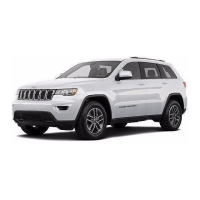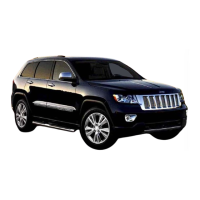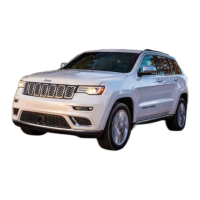Do you have a question about the Jeep Grand Cherokee 2012 and is the answer not in the manual?
Utility vehicles have higher rollover rates due to higher ground clearance and center of gravity.
Explains how to navigate the manual using the table of contents and index.
Details warnings against procedures that could cause collision or injury and cautions for vehicle damage.
Describes the VIN location on the vehicle's instrument panel and body.
Warns that modifications can affect roadworthiness, safety, and may lead to accidents.
Explains the key fob, wireless ignition node, and keyless entry transmitter.
Prevents unauthorized vehicle operation by disabling the engine.
Monitors doors, liftgate, and ignition for unauthorized operation.
Allows locking/unlocking doors and liftgate, activating panic alarm remotely.
Details manual and automatic door locking/unlocking features.
Allows keyless starting and operation of the vehicle.
Explains operation of power window controls and auto-down/up features.
Describes how to open and close the liftgate and liftgate flipper glass.
Details manual and powered operation of the liftgate.
Covers seat belts, airbags, and active head restraints for occupant safety.
Provides guidance on using child seats and LATCH systems safely.
Steps to enable the cruise control system.
Instructions on setting a specific speed for cruise control.
How to increase or decrease the set speed.
How to temporarily or permanently turn off cruise control.
How to use the accelerator for passing while cruise control is active.
Guidance on using cruise control in hilly terrain.
Explains how to enable ACC based on vehicle speed.
Steps to turn on the ACC system and view its status.
Methods to disable ACC without erasing the set speed.
How to re-engage a previously set speed.
Adjusting the set speed and following distance.
How to adjust the distance to the vehicle ahead.
Navigating ACC settings via the EVIC.
Information on ACC system warnings and maintenance.
Important precautions and limitations when using ACC.
Details the sensors and their detection range.
How the system provides visual and audible warnings.
Explains the system status display in REVERSE.
How to turn the ParkSense system on or off.
Troubleshooting and service information for ParkSense.
How to clean the ParkSense sensors.
Important precautions and limitations for using ParkSense.
How to enable/disable the camera via the navigation system.
How to enable/disable the camera via the radio.
Describes the components of the overhead console.
Operation of the front map and reading lights.
Preparations and initial steps before programming HomeLink.
Instructions for programming openers with rolling codes.
Instructions for programming openers with non-rolling codes.
Specific procedures for Canadian or gate operators.
How to reprogram a single HomeLink button.
How to operate devices using HomeLink.
Security considerations for HomeLink, like erasing channels.
Common solutions for HomeLink programming issues.
How to open the sunroof automatically with a quick press.
How to open the sunroof by holding the switch.
How to close the sunroof automatically with a quick press.
How to close the sunroof by holding the switch.
Detects obstructions during express close to prevent injury.
How to override pinch protection for closing.
How to open the sunroof to the vent position automatically.
Manual and automatic operation of the sunshade.
Explains wind buffeting and how to minimize it.
Cleaning instructions for the sunroof glass.
How sunroof switches remain active after ignition is off.
Provides AC power for devices up to 150 Watts.
Location of front and rear cupholders.
General section on storage compartments.
Location and access to the glove compartment.
Describes storage areas built into door panels.
Describes the center console's upper and lower storage areas.
Details the location and operation of the rechargeable flashlight.
Access to the lower storage compartment.
Steps to cover the cargo area with the retractable cover.
Operation of the rear window wiper and washer system.
How to use the rear defroster and heated mirrors.
Indicates engine speed in revolutions per minute.
Alerts driver to potential issues with the airbag system.
Indicates issues with the engine or emissions control system.
Indicates ESC system activation or malfunction.
Illuminates when TOW/HAUL mode is selected.
Shows operation of front and rear turn signals.
Indicates when headlights are on high beam.
Illuminates when front fog lights are on.
Indicates the status of the Hill Descent Control feature.
Displays vehicle information, messages, and total distance driven.
Illuminates when parking or headlights are on.
Reminds occupants to fasten seat belts.
Monitors brake functions, fluid level, and parking brake.
Indicates the status of the Anti-Lock Brake System.
Alerts driver that the vehicle is in four-wheel drive LOW mode.
Indicates vehicle speed.
Points to the side of the vehicle where the fuel door is located.
Shows the level of fuel in the tank.
Displays reconfigurable white telltale lights.
Displays reconfigurable amber caution telltales.
Displays reconfigurable red telltales.
Indicates when the Electronic Stability Control is off.
Indicates arming status of the vehicle theft alarm.
Displays fuel economy data like MPG and DTE.
Shows the status of the Adaptive Cruise Control system.
Displays the current vehicle speed.
Provides trip information like distance and elapsed time.
Shows the tire pressure monitoring system status.
Displays various vehicle warnings and information messages.
Allows customization of vehicle settings.
How to turn off the EVIC menu display.
Shows temperature setting for the left front seat.
Shows current mode selection (Panel, Bi-Level, Floor, Mix).
Shows current blower speed selection.
Shows temperature setting for the right front seat.
Changes the setting to front defrost mode.
Increases passenger temperature setting.
Decreases passenger temperature setting.
Controls airflow, distribution, volume, and recirculation automatically.
Adjusts the fan speed for air circulation.
Turns the climate control system off.
Selects between different air distribution modes.
How to use the automatic temperature control for optimal comfort.
Manual control of airflow direction and blower speed.
Airflow from panel and floor outlets.
Airflow directed through floor outlets.
Airflow from floor, defrost, and side window outlets.
For clearing windshield and side windows.
Manually activates or deactivates the air conditioning system.
Recirculates interior air to prevent outside contaminants.
How to clear fog from windows.
Precautions for operating the system in winter.
Steps for storing the vehicle for extended periods.
Requirements for starting with an automatic transmission.
How to start the vehicle using the keyless system.
Standard procedure for starting the engine.
Special procedures for starting in extremely cold temperatures.
Troubleshooting steps when the engine won't start.
What to do after the engine has started.
Information on using the engine block heater for cold starts.
Ensures the shift lever is in PARK before removing the key.
Requires brake pedal to shift from PARK.
Description of the 5-speed automatic transmission.
Explanation of the different gear positions.
Description of the 6-speed automatic transmission.
Explanation of the different gear positions for the 6-speed transmission.
Instructions for the Quadra-Trac I system.
Instructions for the Quadra-Trac II system.
Explanation of the different 4WD shift positions.
How to shift between 4WD modes.
Details the Quadra-Drive II system features.
How to use the Selec-Terrain™ system for different terrains.
Operation of the Quadra-Lift air suspension system.
Advice for driving on paved surfaces.
Guidance for driving on various off-road surfaces.
Precautions and procedures for driving through water.
Tips for driving in challenging traction conditions.
Advice for driving uphill.
Advice for driving downhill.
Checks to perform after off-road driving.
Description of the electro-hydraulic power steering system for the 3.6L engine.
Description of the standard power steering system for the 5.7L engine.
How to check the power steering fluid level.
Aids vehicle control under adverse braking conditions.
Monitors wheel spin and applies brake pressure.
Optimizes braking capability during emergency maneuvers.
Anticipates and helps prevent wheel lift or rollover.
Enhances directional control and stability.
Explains the markings on tire sidewalls.
Defines terms related to tires and their specifications.
Importance of proper tire inflation and how to check it.
Information on tire loading and pressure placards.
How to determine maximum loading conditions.
Definition of curb weight.
Explains tire size designation on the label.
Appropriate rim size for tire size.
How the TPMS works and its components.
Recommended fuel for the 3.6L engine.
Recommended fuel for the 5.7L engine.
Information on cleaner burning gasoline.
Use of oxygenates like Ethanol in gasoline.
Precautions for using E-85 fuel.
General information for flexible fuel vehicles.
Properties and handling of E-85 fuel.
Recommended fuel types and octane ratings.
Definitions of terms related to trailer towing.
Total allowable weight of the vehicle and trailer.
Definition of payload and its calculation.
Maximum permissible load on front and rear axles.
How to operate hazard warning flashers for emergencies.
Steps to take to reduce the potential for engine overheating.
Essential steps for safely changing a flat tire.
Location of the jack and tire changing tools.
How and where the spare tire is stored.
Steps to take before jacking the vehicle.
Step-by-step guide to safely jacking the vehicle.
Instructions for installing the road tire after changing.
Detailed steps for safely jump-starting the vehicle.
How to move the vehicle if it becomes stuck in snow, sand, or mud.
Location and use of emergency tow hooks.
Procedure to temporarily move the shift lever from PARK.
Vehicle transport procedures for disabled vehicles.
Special procedures for towing without the key fob.
Towing instructions for 2WD models.
Towing instructions for 4WD models.
Identifies major components in the 3.6L engine compartment.
Identifies major components in the 5.7L engine compartment.
Monitors engine, emissions, and transmission systems for performance.
Explains the EVIC message for a loose fuel cap.
Information on emissions testing requirements.
Importance of using genuine MOPAR parts.
Benefits and recommendations for dealer service.
Information on required maintenance services.
Checking and changing engine oil.
Recommends manufacturer's specified engine coolant.
Safety precautions regarding the cooling system pressure cap.
How to check the transfer case fluid level.
Recommended lubricant for the transfer case.
Recommended fluid for optimal transmission performance.
Checking transmission fluid level for 3.6L engine.
Checking transmission fluid level for 5.7L engine.
Cleaning instructions for stain repel fabric seats.
Location and description of fuses and components in the power module.
Lists bulb types for interior lights.
Information on HID headlamps and safety warnings.
Procedures for replacing halogen headlamp bulbs.
Steps to remove and replace the rear liftgate mounted tail lamp.
Details fluids and parts for the engine.
Details fluids and parts for the chassis.
Specifies intervals for essential maintenance services.
Engine oil, tire rotation, filter replacement, and inspection items.
Engine oil, tire rotation, filter replacement, spark plugs, and brake inspection.
Engine oil, tire rotation, filter replacement, spark plugs, and brake inspection.
Engine oil, tire rotation, filter replacement, coolant flush, and brake inspection.
Engine oil, tire rotation, and coolant replacement.
Engine oil, tire rotation, filter replacement, spark plugs, and brake inspection.
Engine oil and tire rotation.
Tips for preparing for a service appointment.
Contact information for customer support and assistance.
Contact information for Chrysler Group LLC customer support.
Contact information for Chrysler Canada customer support.
Contact information for assistance in Mexico.
Assistance options for hearing or speech impaired customers.
Information about service contracts.
Reference to warranty booklet for terms and provisions.
Information on obtaining MOPAR parts.
How to report safety defects to NHTSA and the manufacturer.
How Canadian customers can report safety defects to Transport Canada.
How to order additional manuals and publications.
Comparative rating based on tire wear.
Represents tire's ability to stop on wet pavement.
Tire's resistance to heat generation and dissipation.
| Brand | Jeep |
|---|---|
| Model | Grand Cherokee 2012 |
| Category | Automobile |
| Language | English |











